Ouachita Mountains
The Ouachita Mountains (/ˈwɒʃɪtɔː/), simply referred to as the Ouachitas, are a mountain range in western Arkansas and southeastern Oklahoma. They are formed by a thick succession of highly deformed Paleozoic strata constituting the Ouachita Fold and Thrust Belt, one of the important orogenic belts of North America.[3] The Ouachitas continue in the subsurface to the northeast where they make a poorly understood connection with the Appalachians and to the southwest where they join with the Marathon uplift area of West Texas.[3] Together with the Ozark Plateaus, the Ouachitas form the U.S. Interior Highlands.[4] The highest natural point is Mount Magazine at 2,753 feet.[2][5]
| Ouachita Mountains | |
|---|---|
 The Ouachita Mountains near Caney Creek, Arkansas | |
| Highest point | |
| Peak | Mount Magazine |
| Elevation | 2,753 ft (839 m) |
| Coordinates | 35°10′01″N 93°38′41″W |
| Naming | |
| Etymology | Choctaw for "large buffaloes"[1] or "big hunt",[1] or Caddo[2] |
| Geography | |
| Country | United States |
| State | Arkansas and Oklahoma |
| Parent range | U.S. Interior Highlands |
Etymology
Louis R. Harlan claimed that "Ouachita" is composed of the Choctaw words ouac for "buffalo" and chito for "large", together meaning "country of large buffaloes". At one time, herds of buffalo inhabited the lowland areas of the Ouachitas.[6] Historian Muriel H. Wright wrote that "Ouachita" is composed of the Choctaw words owa for "hunt" and chito for "big", together meaning "big hunt far from home".[1] According to the article Ouachita in the Encyclopedia of Oklahoma History and Culture, "Ouachita" comes from the French spelling of the Caddo word washita, meaning "good hunting grounds".[2]
Geography
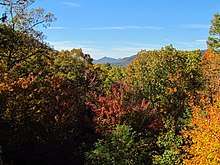
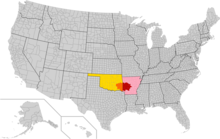
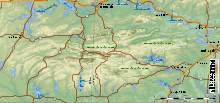
The Ouachitas are a major physiographic province of Arkansas and Oklahoma and are generally grouped with the Arkansas River Valley. Together with the Ozark Plateaus, the Ouachitas form the U.S. Interior Highlands, one of few mountainous regions between the Appalachians and Rockies.[4]
Flora
The Ouachitas are dominated by pine, oak, and hickory.[7] The shortleaf pine (Pinus echinata) and post oak (Quercus stellata) thrive in dry, nutrient-poor soil and are common in upland areas. The maple-leaf oak (Quercus acerifolia) is found at only four sites worldwide, all of which are in the Ouachitas.[7] Some native tree species, such as the eastern red-cedar (Juniperus virginiana), are colonizers of human-disturbed sites.[7]
The Ouachita National Forest covers approximately 1.8 million acres of the Ouachitas.[8] It is one of the largest and oldest national forests in the Southern U.S., created through an executive order by President Theodore Roosevelt on December 18, 1907.[8] There are six wilderness areas within the Ouachita National Forest, which are protected areas designed to minimize the impacts of human activities.[9]
Several plants are endemic to the Ouachitas, including: Agalinis nuttallii, Cardamine angustata var. ouachitana, Carex latebracteata, Galium arkansanum var. pubifolium, Houstonia ouachitana, Hydrophyllum brownei, Liatris compacta, Quercus acerifolia, Polymnia cossatotensis, Solidago ouachitensis, Spiranthes niklasii (near endemic, also found on Crowley's Ridge), Streptanthus maculatus subsp. obtusifolius, Streptanthus squamiformis, Valerianella palmerii, and Vernonia lettermanii.[10]
Fauna
Bison and elk once found habitat in the Ouachita Mountains, but have since been extirpated. Today, there are large populations of white-tailed deer, coyote, and other common temperate forest animals. Though elusive, hundreds of black bear roam the Ouachitas. Several cryptic species of salamander are endemic to the Ouachitas and have traits that vary from one locale to another.[11]
Subranges
The Athens Piedmont consists of a series of low relief ridges, none exceeding 1,000 feet. It is located south of the Ouachitas and extends from Arkadelphia, Arkansas to the Arkansas-Oklahoma border. The Athens Piedmont runs through Clark, Howard, Pike, and Sevier counties in Arkansas and McCurtain County in Oklahoma.
The Caddo, Cossatot, and Missouri mountains are a high, compact group of mountains composed of the weather-resistant Arkansas Novaculite. They are located primarily in Montgomery and Polk counties, Arkansas. The highest natural point is Raspberry Mountain at 2,358 feet. The headwaters of multiple rivers are found in this area, including the Caddo, Cossatot, and Little Missouri rivers.
The Cross Mountains are located in Polk and Sevier counties, Arkansas and McCurtain County, Oklahoma. The highest natural point is Whiskey Peak at 1,670 feet.
The Crystal Mountains are located primarily in Montgomery County, Arkansas. They are so named because of the occurrence of some of the world's finest quartz. The Crystal Mountains are generally taller than the nearby Zig Zag Mountains, achieving elevations over 1,800 feet.
The Fourche Mountains are a long, continuous chain of mountains composed of the weather-resistant Jackfork Sandstone. They extend from Pulaski County, Arkansas to Atoka County, Oklahoma and are home to several popular sites of interest, including Pinnacle Mountain State Park near Little Rock, Arkansas. The highest natural point is Rich Mountain at 2,681 feet, which intersects the Arkansas-Oklahoma border near Mena, Arkansas. The Fourche Mountains form a major watershed divide between the Arkansas River Basin to the north and the Red River Basin to the south.
The Frontal Ouachita Mountains are located in the Arkansas River Valley and feature a number of isolated landforms. The highest natural point is Mount Magazine at 2,753 feet, which is also the highest natural point of the Ouachitas and U.S. Interior Highlands. The Frontal Ouachita Mountains are structurally quite different from the rest of the Ouachitas and are sometimes considered a separate range.
The Trap Mountains are located primarily in Garland and Hot Spring counties, Arkansas. The highest natural point is Trap Mountain at 1,310 feet.
The Zig Zag Mountains are located in Garland County, Arkansas and are home to the thermal springs of Hot Springs National Park. They are so named because of their unique chevron shape when viewed from above, the result of plunging anticlines and synclines. The Zig Zag Mountains are not exceptionally tall, but do reach heights over 1,400 feet.
Geology

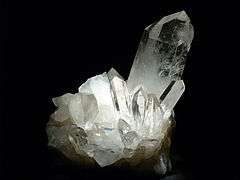
The Ouachitas are formed by a thick succession of highly deformed Paleozoic strata constituting the Ouachita Fold and Thrust Belt, which outcrops for approximately 220 miles in western Arkansas and southeastern Oklahoma.[3] In a general sense, the Ouachitas are considered an anticlinorium because the oldest known rocks are located towards the center of the outcrop area.[12] The Ouachitas continue in the subsurface to the Black Warrior Basin of Alabama and Mississippi where they plunge towards the Appalachian Mountains.[13] To the southwest, the Ouachitas join with the Marathon area of west Texas where rocks of the Ouachita Fold and Thrust Belt are briefly exposed.[3]
Unlike many ranges in the United States, the Ouachitas are mostly east-west trending. They are unique because metamorphism and volcanism, features that are common in orogenic belts, are notably absent (with the exception of some low-grade metamorphism). Due to the high degree of folding and faulting, the Ouachitas are clustered into distinct subranges, with ridges separated by relatively broad valleys.
The Ouachitas are known for some of the world's finest quartz, especially around Mount Ida, Arkansas, the quartz capital of the world.[14] The quartz formed after the Ouachita Orogeny when fractures in rocks filled with silica-saturated fluids and, over millions of years, precipitated crystals up to several feet in length. The Ouachitas are also known for novaculite, a variety of chert that has undergone low-grade metamorphism; particular grades found only in Arkansas are used for making whetstones.
History
Cambrian through Mississippian strata of the Ouachitas were deposited in a narrow, two-sided basin called the Ouachita Trough, which formed as part of a Cambrian failed rift system.[3][15] Succeeding Pennsylvanian strata of the Ouachitas were deposited in a foreland basin during the early stages of the Ouachita Orogeny.[16] Subduction of the South American Plate beneath the North American Plate resulted in this mountain-building event.[17] Compressional forces caused the crust to buckle, producing complex folds at all scale levels and several overturned sequences.[12] The area of greatest deformation occurred in the Benton-Broken Bow Uplift, which extends from Benton, Arkansas to Broken Bow, Oklahoma.[3] The total height of the Ouachitas is not known, though they may have exceeded 10,000 feet (based loosely on geologic cross-sections).[12] The terrain has been deeply eroded since the late Paleozoic.[3]
Stratigraphy
The Ouachitas are composed of Cambrian through Pennsylvanian sedimentary rocks. The Collier Shale, located at the core of the Benton-Broken Bow Uplift, is the oldest exposed formation of the Ouachitas. The Atoka Formation, which was deposited much later during the Pennsylvanian, has the largest areal extent of any of the Paleozoic formations in Arkansas.[12] The geologic formations of the Ouachitas are as follows (in order of ascending age).
| Formation | Period | Approximate thickness |
|---|---|---|
| Collier Shale | Late Cambrian and Early Ordovician | 1,000 feet |
| Crystal Mountain Sandstone | Early Ordovician | 850 feet |
| Mazarn Shale | Early Ordovician | 2,500 feet |
| Blakely Sandstone | Middle Ordovician | 700 feet |
| Womble Shale | Middle Ordovician | 1,200 feet |
| Bigfork Chert | Middle and Late Ordovician | 750 feet |
| Polk Creek Shale | Late Ordovician | 225 feet |
| Blaylock Sandstone | Silurian | 1,200 feet |
| Missouri Mountain Shale | Silurian | 300 feet |
| Arkansas Novaculite | Devonian and Early Mississippian | 900 feet |
| Stanley Shale | Mississippian | 10,000 feet |
| Jackfork Sandstone | Early Pennsylvanian | 6,000 feet |
| Johns Valley Shale | Early Pennsylvanian | 1,500 feet |
| Atoka Formation | Early and Middle Pennsylvanian | 25,000 feet |
| Hartshorne Sandstone | Middle Pennsylvanian | 300 feet |
| McAlester Formation | Middle Pennsylvanian | 2,300 feet |
| Savanna Formation | Middle Pennsylvanian | 1,600 feet |
| Boggy Formation | Middle Pennsylvanian | 1,100 feet |
Tourism
The Ouachita Mountains contain the Ouachita National Forest, Hot Springs National Park and Lake Ouachita, as well as numerous state parks and scenic byways mostly throughout Arkansas. They also contain the Ouachita National Recreation Trail, a 223-mile-long (359 km) hiking trail through the heart of the mountains. The trail runs from Talimena State Park in Oklahoma to Pinnacle Mountain State Park near Little Rock. It is a well maintained, premier trail for hikers, backpackers, and mountain bikers (for only selected parts of the trail).
The Talimena Scenic Drive begins at Mena, and traverses 54 miles (87 km) of Winding Stair and Rich Mountains, long narrow east-west ridges which extend into Oklahoma. Rich Mountain reaches an elevation of 2,681 feet (817 m) in Arkansas near the Oklahoma border. The two lane winding road is similar in routing, construction, and scenery to the Blue Ridge Parkway of the Appalachian Mountains.[18]
Sites of interest
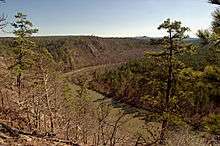
- Black Fork Mountain Wilderness
- Caney Creek Wilderness
- Cossatot River State Park-Natural Area
- Flatside Wilderness
- Hot Springs National Park
- Jack Creek Recreation Area
- Lake Catherine
- Lake Hamilton
- Lake Maumelle
- Lake Ouachita
- Mount Magazine State Park
- Pinnacle Mountain State Park
- Queen Wilhelmina State Park
History
The mountains were home to the Ouachita tribe, for which they were named. Later French explorers translated the name to its present spelling. The first recorded exploration was in 1541 by Hernando de Soto. Later, in 1804, President Jefferson sent William Dunbar and Dr. George Hunter to the area after the Louisiana Purchase. Hot Springs National Park became one of the nation's first parks in 1832. The Battle of Devil's Backbone was fought here at the ridge of the same name in 1863. In August 1990, the U.S. Forest Service discontinued clearcutting as the primary tool for harvesting and regenerating short leaf, pine and hardwood forests in the Ouachita National Forest.
References
- Wright, M.H. (1929). "Some Geographic Names of French Origin in Oklahoma". Chronicles of Oklahoma. 7 (2): 188–193.
- Cole, S.R.; Marston, R.A. (2009). Encyclopedia of Oklahoma History and Culture. Oklahoma Historical Society. Missing or empty
|title=(help) - Morris, R.C. (1974). "Sedimentary and Tectonic History of the Ouachita Mountains". Special Publications of SEPM. 22: 120–142.
- "A Tapestry of Time and Terrain". U.S. Geological Survey. Retrieved October 13, 2007.
- "MAG". NGS data sheet. U.S. National Geodetic Survey. Retrieved December 16, 2008.
- Harlan, L.R. (1834). "Notice of Fossil Bones Found in the Tertiary Formation of the State of Louisiana". Transactions of the American Philosophical Society. 4: 397–403. doi:10.2307/1004838. JSTOR 1004838.
- "Trees". Central Arkansas Library System. Retrieved November 28, 2017.
- "Ouachita National Forest". Central Arkansas Library System. Retrieved November 28, 2017.
- "Wilderness Areas (Ouachita National Forest)" (PDF). U.S. Forest Service. Retrieved December 2, 2017.
- Zollner, Douglas; MacRoberts, Michael H.; MacRoberts, Barbara R.; Ladd, Douglas (2005). "Endemic Vascular Plants of the Interior Highlands, U.s.a". SIDA, Contributions to Botany. 21 (3): 1781–1791. ISSN 0036-1488. JSTOR 41968453.
- Shepard, Donald B.; Irwin, Kelly J.; Burbrink, Frank T. (December 2011). "Morphological Differentiation in Ouachita Mountain Endemic Salamanders". Herpetologica. 67 (4): 355–368. doi:10.1655/HERPETOLOGICA-D-11-00023.1. ISSN 0018-0831.
- "Stratigraphic Summary of the Arkansas River Valley and Ouachita Mountains". Arkansas Geological Survey. Archived from the original on May 29, 2018. Retrieved October 26, 2017.
- Mellen, F.F. (1947). "Black Warrior Basin, Alabama and Mississippi". AAPG Bulletin. 31 (10): 1801–1816. doi:10.1306/3d933a55-16b1-11d7-8645000102c1865d.
- "Quartz Crystals". Arkansas Department of Parks & Tourism. Retrieved November 25, 2017.
- Lowe, D.R. (1985). "Ouachita Trough: Part of a Cambrian Failed Rift System". Geology. 13 (11): 790–793. Bibcode:1985Geo....13..790L. doi:10.1130/0091-7613(1985)13<790:otpoac>2.0.co;2.
- Shanmugam, G.; Moiola, R.J. (1995). "Reinterpretation of Depositional Processes in a Classic Flysch Sequence (Pennsylvanian Jackfork Group), Ouachita Mountains, Arkansas and Oklahoma". AAPG Bulletin. 79 (5): 672–695. doi:10.1306/8d2b1b6a-171e-11d7-8645000102c1865d.
- Hatcher, R.D. Jr.; Thomas, W.A.; Viele, G.W., eds. (1989). The Appalachian-Ouachita Orogen in the United States (Geology of North America). Colorado: Geological Society of America.
- http://www.trais.com/tcatalog_trail.aspx?trailid=XFA101-040 Archived July 17, 2011, at the Wayback Machine, accessed 11 Mar 2011
External links
| Wikimedia Commons has media related to Ouachita Mountains. |
- Geology of the Ouachita Mountains, from a rockhound's perspective.[dead link|date]
- Friends of the Ouachita Trail (FoOT)
- Lakeouachita.org: Lake Ouachita — largest lake in the Ouachita Mountains.

